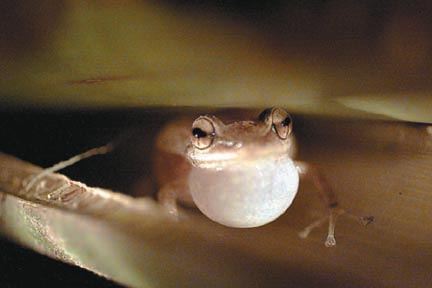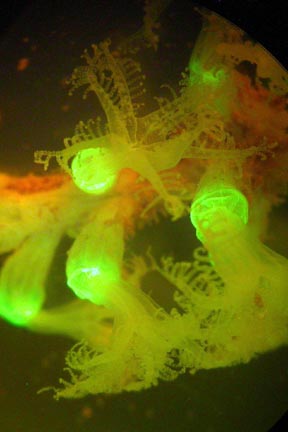
STAR-BULLETIN
The coqui frog, a native of Puerto Rico, threatens native ecosystems and is the subject of an ongoing eradication program.
Hawaii shows leadership
in fighting alien speciesState efforts to combat disruptive
invaders serve as a model for
a national committee
Coqui frogs keep Big Islanders up at night.
Miconia gobbles up acres of Maui rain forest.
The bad news is that, left unchecked, invasive plants and animals could devastate Hawaii's ecology, economy and quality of life.
The good news that the state sometimes nicknamed the "endangered species capital of the world" is well ahead of many other states in battling its alien invaders.
"I'm completely impressed with what I see in Hawaii," said Ron Luckens, a Mississippi member of the 32-member National Invasive Species Advisory Committee, which met in Waikiki last week.
"Things happen faster here (in Hawaii), and their (Hawaii residents') ability to respond is like a model for us," Luckens said. "On the continent, most people don't know what an invasive species is. Here you have a grass-roots movement."
Hawaii scientists explained to the national panel last week many of the invasive species problems facing Hawaii's native plants and animals. An invasive species is a non-native species that threatens the natural ecology or human economy of a place.
"It's important for people in Hawaii to understand that although we've got some of the worst problems, we've got some of the most innovative ways of dealing with them," said Mike Buck, administrator of the state Division of Forestry & Wildlife, and one of two Hawaii members on the national committee.
COURTESY OF SAMUEL KAHNG
Snowflake coral, a soft coral from the Western Atlantic, overtakes native black coral, part of the lucrative local jewelry industry.
The meeting last week, which included field trips on Oahu, Maui and the Big Island, "is a chance to show people in the rest of the nation what we're doing. We're out in front on a lot of things," Buck said.
Hawaii is one of seven states that has a state-level invasive species council. The Legislature established the Cabinet-level council last year to coordinate the battle against invasive species. It is co-chaired by the directors of the state departments of Agriculture and Land & Natural Resources.
Gov. Linda Lingle spoke to the national panel Tuesday, stressing that fighting invasive species is not only good for the natural world, but also makes business sense.
Lingle told the panel members that "she knows the interrelationship of the environment and the economy and the quality of life for people," said DLNR Director Peter Young. "We 'get it' as a state."
Lingle's budget proposal for next year includes $5 million in new money to battle invasive species, which the state believes can be used to leverage at least that much in matching federal and private funds, Young said.
By committing $10 million a year in new money each of the next four years, the state can make inroads into its invasive species problems, Young said.
Hawaii's plan would focus efforts on 18 priority species or problems, including the coqui frog, miconia, fountain grass, alien algae, the fruit fly and fireweed.
Some of the problem species are not yet in Hawaii, but are a priority to keep out. They include the brown tree snake, West Nile virus, biting flies and the red imported fire ant.
"Prevention is the best money spent," Young said.
Young said his department is opposing all bills before the Legislature that address a particular invasive species issue -- not because it opposes fighting that battle, but because it believes a coordinated, statewide plan is the way to go.
Since the invasive species proposal is in the governor's budget, it will not be known until the end of the session if lawmakers buy it.
Spending the money "makes good business sense," Buck said. "It's the right thing to do."
Hawaii's least-wanted species list
-- Coqui frog, a Puerto Rican frog with a loud, piercing call that disturbs many people and threatens native ecosystems. Present in Hawaii. Control and eradication efforts under way.-- Miconia, a fast-growing South American plant that shades out native vegetation in forests, which in turn creates erosion problems and reduces the ability of the underlying aquifer to store fresh water. Present in Hawaii. Control and eradication efforts under way.
-- Brown tree snake, a New Guinea native that has decimated Guam's bird population. Since 1981 eight snakes, including three that were still alive, have been intercepted by Hawaii screening programs. Enhanced screening efforts sought.
-- West Nile virus, the mosquito-transmitted disease that is a health risk for native Hawaiian birds as well as horses and humans. Spread from East to West coasts of the mainland in four years. Not in Hawaii. Enhanced screening efforts sought.
-- Red imported fire ants, highly aggressive South American ants that can cause death, injury and weight loss in cattle and poultry. They also damage electrical equipment and destroy crops. Present on the mainland but not in Hawaii. Enhanced screening efforts sought.
-- Non-native algae can smother coral reefs, destroying the underwater ecosystem. Various species are present. Control and eradication efforts under way.
-- Snowflake coral, an alien, soft coral from the Western Atlantic that overtakes native black coral. Present in Hawaii. Research to develop strategy under way.
-- Biting flies, from a variety of worldwide sources, could harm Hawaii's tourist-based economy, change local lifestyles and damage native wildlife. Not in Hawaii.
-- Fountain grass, a fast-growing, highly flammable grass that threatens native plants and is a fire risk. Present in Hawaii. Control and eradication efforts under way.
-- Fireweed, from Africa, is toxic to grazing animals. Present in Hawaii. Control and eradication efforts under way.
-- Fruit flies, agricultural pests, are present in Hawaii. Control and eradication efforts under way.
SOURCE: HAWAII INVASIVE SPECIES COUNCIL

